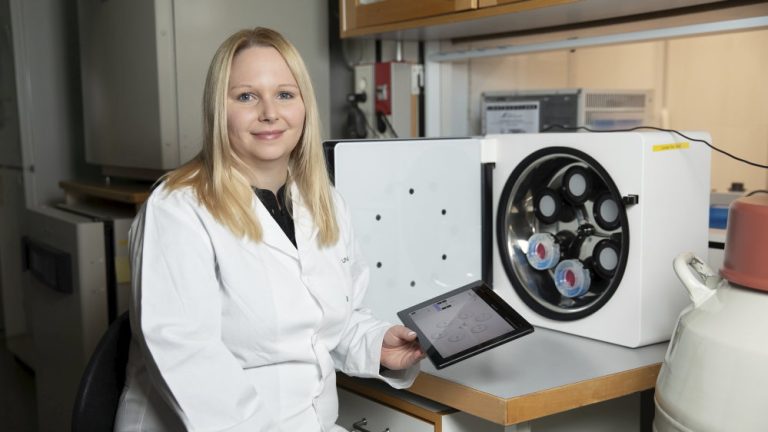The ability to investigate various treatment options without the need to use animals or expose humans to unnecessary treatments is an important goal in medical research. In Maria Schröder’s PhD project at the School of Dentistry, she developed 3D tissue-like models of oral tissues that can help study the gum disease periodontitis.
When cells in the body build or repair tissue, they grow in three dimensions (3D), making it vital to develop models that allow human cells to grow in the same way in the lab.
“The aim of my PhD thesis was to develop 3D tissue-like cell models based on cells from oral tissues, such as the periodontal ligament and bone, to better understand how cells are affected by various stimuli,” explains Maria Schröder.
Bioreactors and diffusion reactors in cell models
The 3D cell model was created using rotating bioreactors and diffusion reactors. A bioreactor is a technical device used in laboratories and industrial production to cultivate and maintain living cells or microorganisms under controlled and optimal conditions. In a bioreactor, you can control key factors such as temperature, pH value, nutrients and oxygen content, as well as other stimulating factors such as mechanical forces. As the cells spin in the solution inside the bioreactor, they bond together and build tissue-like structures on their own.
A diffusion reactor is a special type of bioreactor where the organ or cells being cultured are affected by fluid flows. Such fluid flows ensure that cells receive a constant supply of nutrients and oxygen and that waste products are removed, similar to the way blood and lymph fluid work in the body.
“In summary, we can say that both bioreactors and infusion reactors allow us to simulate the natural environment in which cells live,” explains Schröder. These models give us the opportunity to study and identify, for example, disease mechanisms and therapeutic effects in a more precise and detailed way.
Periodontitis
Periodontitis manifests as inflammation of the periodontal tissue that surrounds the tooth. If left unchecked, the inflammation can cause the tooth to detach from the jawbone after the surrounding tissue is destroyed and bone is lost, eventually resulting in mobility and tooth loss.
“In addition to the risk of tooth loss, research shows that periodontitis can negatively affect overall health,” adds Maria Schröder.
Can you explain this further?
“Gingival inflammation is painful for patients, and in addition to potentially leading to tooth loss, it can also trigger an immune response in the body as inflammatory signals in the gums can spread to the rest of the body through the bloodstream.” explains Maria Schroeder.
The aim of the PhD thesis was therefore to develop 3D tissue-like models that can contribute to building knowledge on how to repair tissues affected by periodontitis.
“And my goal was to see if I could create conditions that allow cells to grow the way they grow in the body,” explains Maria Schröder.
Vitamins
There are vitamins that are known to affect bone growth, and vitamins D and K2 are among them. These are vitamins that patients are often advised to take as dietary supplements. The effect of these vitamins on tissue formation was examined in the three-dimensional models.
“As a continuation of the work, I examined how the cells reacted to exposure to vitamins D and K2 and whether only one of these vitamins or both together are more beneficial for the repair and growth of lost tissue,” says Maria Schröder.
On their own, the two vitamins had slightly different results. In periodontal cells, vitamin K2 affected collagen production and the structures that hold cells together, while vitamin D increased protein factors that stimulate cells to form bone.
“In the 3D cell-based bone model, it was found that vitamin D increased the mechanical stiffness of the bone tissue, while K2 increased the mechanical flexibility. This indicates that supplementation with vitamin D and K2 can help strengthen bone structure .” says Schroeder.
Mechanical influence
But there were other factors studied in the models.
“When we chew food, not only the teeth but also all the surrounding tissue is affected by mechanical forces,” explains Maria. In addition to vitamins, we could also study mechanical effects, such as movement and pressure, in our models. The aim was to investigate how these stimuli affected the cells and their functions.
Overall, this thesis provides valuable insights into how laboratory models can be developed to study disease mechanisms, drug effects, or how cells/tissues can be stimulated to grow. It is an important contribution to further periodontitis research and can be used to develop more effective treatments in the future.

